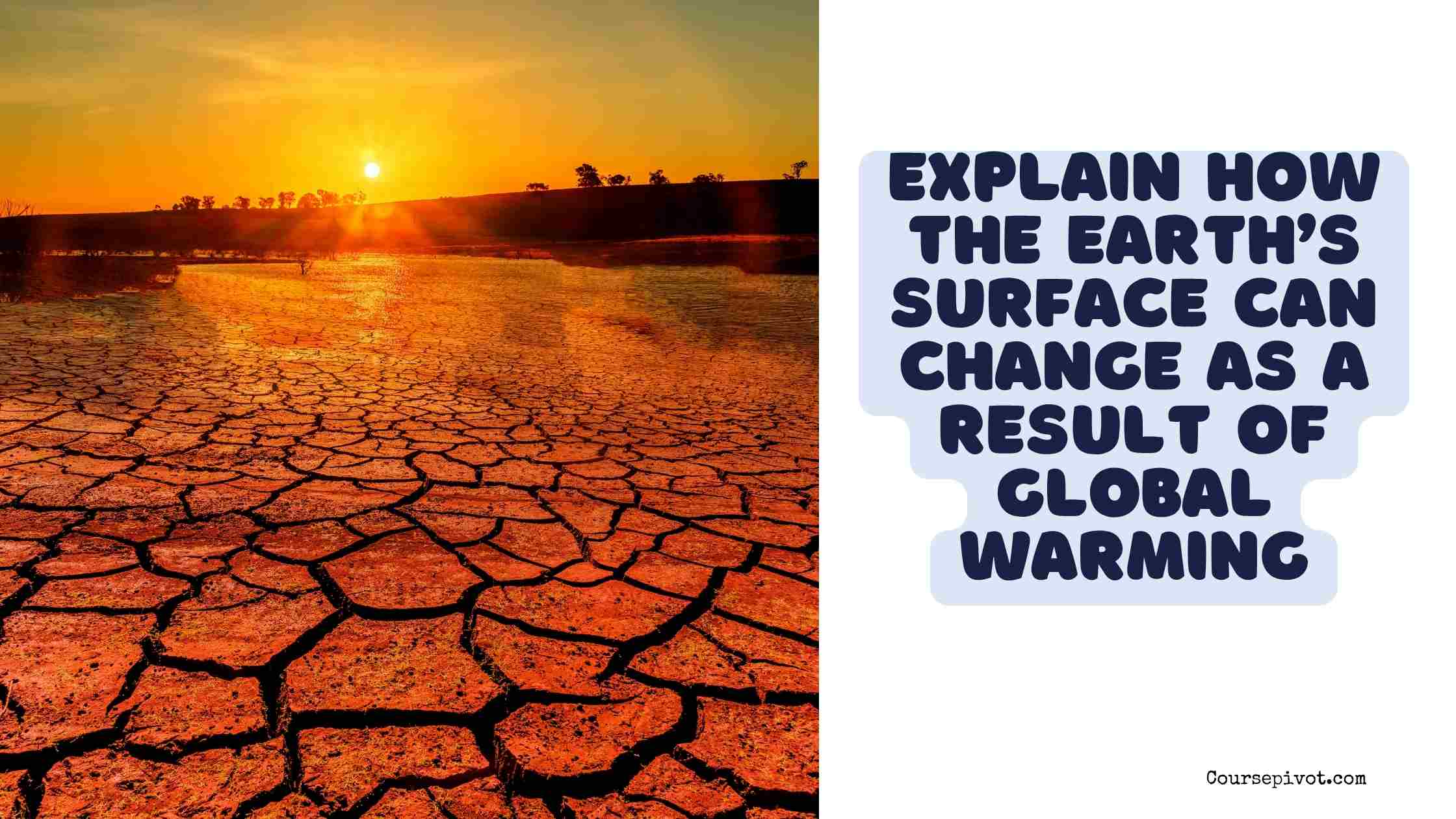
How Global Warming Changes Earth’s Surface
Have you ever noticed how extreme weather or rising seas seem to reshape the places we know? I’ve been struck by images of melting glaciers and flooded coastlines, wondering how global warming is altering our planet’s very surface. The question Explain how the Earth’s surface can change as a result of global warming dives into a critical issue driven by human activity and its visible impacts. In this blog, I’ll explain how global warming transforms Earth’s surface, focusing on rising sea levels, melting ice, desertification, coastal erosion, and shifting ecosystems.
Table of Contents
Global warming, caused by greenhouse gas emissions, raises Earth’s average temperature, triggering physical changes to landscapes and coastlines. This matters because these shifts threaten 3 billion people living in vulnerable areas by 2050, per UN data. I’ve seen how storms reshape beaches near me, hinting at broader changes. Let’s explore how warming reshapes our planet’s surface.
Why should you care? Because these changes affect your home, food, and future. This article will outline key impacts, provide examples, and reflect on their significance. Ready to see how global warming redraws Earth’s map? Let’s get started.
What Is Global Warming?
Global warming is the long-term increase in Earth’s average surface temperature due to human activities, primarily burning fossil fuels, which release greenhouse gases like CO2. Since the late 19th century, temperatures have risen 1.1°C, with projections of 1.5–4°C by 2100, per IPCC 2023 data. This warming drives physical changes to Earth’s surface, from melting ice to shifting landforms.
I find it sobering that our energy choices are literally reshaping the planet beneath our feet.
How Global Warming Changes Earth’s Surface
Global warming alters Earth’s surface through rising sea levels, melting ice and glaciers, desertification and land degradation, coastal erosion and flooding, and shifting ecosystems and land use. Here’s how each process works:
Rising Sea Levels
Warming causes oceans to rise, flooding low-lying areas:
- Thermal Expansion: Warmer water expands, contributing 50% to sea level rise—global seas have risen 8–9 inches since 1880, per NOAA.
- Melting Ice: Glacial and polar ice melt adds water, accelerating rise—Antarctica and Greenland lose 400 billion tons of ice yearly, per NASA.
- Impacts: Coastal cities like Miami face frequent flooding, with 40% of global population at risk by 2050, per UN. Islands like the Maldives could vanish.
In Bangladesh, 20 million people face displacement as seas encroach 1.5 mm yearly, per local data. I’m alarmed by how entire communities could be submerged.
Melting Ice and Glaciers
Warming accelerates ice loss, reshaping landscapes:
- Glacier Retreat: 90% of glaciers, like those in the Alps, are shrinking, losing 30 meters of length yearly, per WMO.
- Permafrost Thaw: 20% of Arctic permafrost is thawing, releasing methane and destabilizing land, affecting 4 million people, per NSIDC.
- New Landforms: Retreating ice exposes barren rock or creates lakes, altering topography, as seen in Patagonia.
Greenland’s ice loss reshapes its coastline, creating new fjords. I see how melting ice redraws maps and threatens climate stability.
Desertification and Land Degradation
Warming dries soils, expanding deserts:
- Increased Aridity: Higher temperatures and erratic rainfall degrade 25% of global land, per UNCCD, turning fertile areas into deserts.
- Soil Erosion: Droughts and heat reduce vegetation, with 1.5 billion tons of topsoil lost yearly in Africa, per FAO.
- Habitat Loss: Arid lands, like the Sahel, displace 24 million people, per UNHCR, as farmland fails.
In Australia, desertification claims 12% of arable land, per government reports. I’m concerned by how once-green areas turn barren, threatening food security.
Coastal Erosion and Flooding
Warming intensifies storms, eroding shores:
- Stronger Storms: Rising sea temperatures fuel hurricanes, with 30% more intense storms since 1980, per NOAA, eroding coastlines.
- Wave Impact: Higher seas amplify wave energy, removing 50 meters of U.S. coastlines yearly, per USGS.
- Infrastructure Damage: Ports and roads, like in Jakarta, collapse, costing $1 trillion globally by 2050, per OECD.
In Louisiana, 2,000 square miles of coast have vanished since 1930, per state data. I’m stunned by how fast waves can reshape shores.
Shifting Ecosystems and Land Use
Warming alters where plants and animals thrive, changing land:
- Biome Shifts: Forests turn to grasslands as temperatures rise, with 20% of ecosystems shifting by 2100, per Nature.
- Agricultural Changes: Crop zones move poleward, with 10% of farmland becoming unsuitable by 2050, per IPCC, forcing land repurposing.
- Urban Expansion: Displaced populations drive deforestation for settlements, with 700 million climate migrants projected, per World Bank.
In Canada, warming allows farming farther north, but tundra loss disrupts indigenous lands. I find it bittersweet how new opportunities come at such a cost.
Real-World Example
In the Arctic, global warming melts permafrost and sea ice, changing the surface dramatically. Temperatures have risen 2°C since 1900, per NOAA, thawing 1.5 million square miles of permafrost. This causes land to sink, damaging roads and homes in Alaska, costing $400 million yearly, per state estimates. Coastal erosion, worsened by storm surges, wipes out villages like Shishmaref, displacing 600 residents. These changes show warming’s direct impact on Earth’s surface.
I’m moved by how Arctic communities lose their homes to a warming world, a stark reminder of global stakes.
Why These Changes Matter
Surface changes from global warming are critical because:
- Human Displacement: 1 billion people could be displaced by 2050, per UN, straining economies and societies.
- Economic Costs: Damage to land and infrastructure could cost $54 trillion globally by 2100, per IPCC.
- Food and Water Security: Desertification and flooding threaten 20% of global food production and 40% of freshwater, per FAO.
- Biodiversity Loss: 30% of species face extinction as habitats shift, per IUCN, disrupting ecosystems.
I see these changes as a wake-up call, urging action to protect our planet’s surface.
Mitigating Surface Changes
Solutions to slow these impacts include:
- Reduce Emissions: Cut CO2 via renewables, aiming for net-zero by 2050, adopted by 130 countries, per UN.
- Protect Ecosystems: Reforest 1 billion hectares by 2030, per Bonn Challenge, to stabilize soils and carbon.
- Adapt Infrastructure: Build sea walls or elevate cities, with $1 trillion invested in resilience, per World Bank.
- Sustainable Land Use: Use drought-resistant crops, saving 20% of water, per CGIAR.
I support these efforts, knowing they preserve the Earth’s surface for future generations.
Challenges in Addressing Changes
Action faces hurdles:
- Economic Costs: Mitigation requires $100 trillion by 2050, per IPCC, straining budgets.
- Political Resistance: Fossil fuel reliance slows policy shifts, with $1 trillion in subsidies yearly, per IMF.
- Inequity: Developing nations, contributing 20% of emissions, face 80% of impacts, per UN, needing global aid.
- Time Lag: Surface changes continue despite cuts, with 50% of sea rise locked in, per NASA.
I’m frustrated by delays but hopeful that unified action can limit damage.
Preserving Our Planet’s Surface: Key Takeaways
The question Explain how the Earth’s surface can change as a result of global warming reveals that rising sea levels, melting ice, desertification, coastal erosion, and ecosystem shifts reshape landscapes and coastlines. Driven by a 1.1°C temperature rise, these changes threaten billions, as seen in Arctic erosion or Bangladesh flooding. I’m inspired by mitigation efforts but sobered by their scale and urgency.
Read our blog on How Factory CFC Emissions Affect People
Why should you care? Because global warming’s surface changes threaten your home and future. What’s stopping you from acting? Support green policies, reduce your carbon footprint, and advocate for a stable Earth today.
Summarized Answer
Global warming changes Earth’s surface through rising sea levels (8–9 inches since 1880), melting ice and glaciers, desertification (25% of land degraded), coastal erosion from stronger storms, and shifting ecosystems, threatening billions with displacement, economic loss, and reduced food security.
Cite this article
You can copy and paste your preferred citation format below.
Martin, L. & Arquette, E.. (2025, June 6). How Global Warming Changes Earth’s Surface. Coursepivot.com. https://coursepivot.com/blog/how-global-warming-changes-earths-surface/



